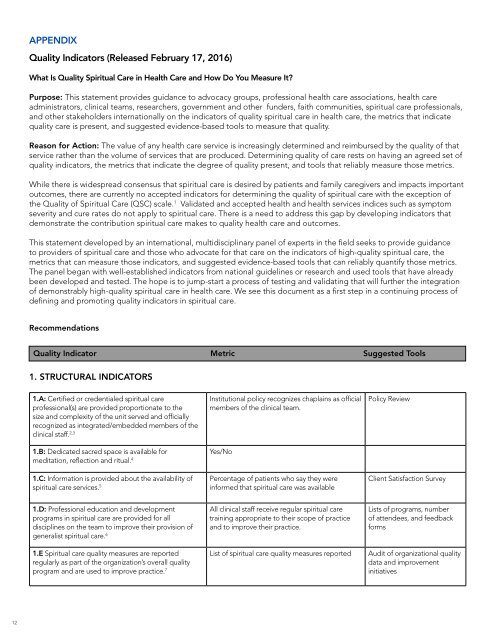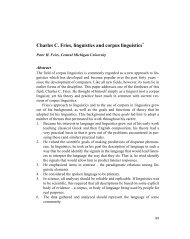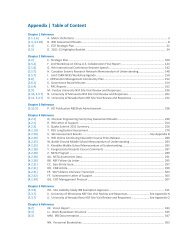TIME TO MOVE FORWARD
time_to_move_forward_report_2016-06-07
time_to_move_forward_report_2016-06-07
Create successful ePaper yourself
Turn your PDF publications into a flip-book with our unique Google optimized e-Paper software.
APPENDIX<br />
Quality Indicators (Released February 17, 2016)<br />
What Is Quality Spiritual Care in Health Care and How Do You Measure It?<br />
Purpose: This statement provides guidance to advocacy groups, professional health care associations, health care<br />
administrators, clinical teams, researchers, government and other funders, faith communities, spiritual care professionals,<br />
and other stakeholders internationally on the indicators of quality spiritual care in health care, the metrics that indicate<br />
quality care is present, and suggested evidence-based tools to measure that quality.<br />
Reason for Action: The value of any health care service is increasingly determined and reimbursed by the quality of that<br />
service rather than the volume of services that are produced. Determining quality of care rests on having an agreed set of<br />
quality indicators, the metrics that indicate the degree of quality present, and tools that reliably measure those metrics.<br />
While there is widespread consensus that spiritual care is desired by patients and family caregivers and impacts important<br />
outcomes, there are currently no accepted indicators for determining the quality of spiritual care with the exception of<br />
the Quality of Spiritual Care (QSC) scale. 1 Validated and accepted health and health services indices such as symptom<br />
severity and cure rates do not apply to spiritual care. There is a need to address this gap by developing indicators that<br />
demonstrate the contribution spiritual care makes to quality health care and outcomes.<br />
This statement developed by an international, multidisciplinary panel of experts in the field seeks to provide guidance<br />
to providers of spiritual care and those who advocate for that care on the indicators of high-quality spiritual care, the<br />
metrics that can measure those indicators, and suggested evidence-based tools that can reliably quantify those metrics.<br />
The panel began with well-established indicators from national guidelines or research and used tools that have already<br />
been developed and tested. The hope is to jump-start a process of testing and validating that will further the integration<br />
of demonstrably high-quality spiritual care in health care. We see this document as a first step in a continuing process of<br />
defining and promoting quality indicators in spiritual care.<br />
Recommendations<br />
Quality Indicator Metric Suggested Tools<br />
1. STRUCTURAL INDICA<strong>TO</strong>RS<br />
1.A: Certified or credentialed spiritual care<br />
professional(s) are provided proportionate to the<br />
size and complexity of the unit served and officially<br />
recognized as integrated/embedded members of the<br />
clinical staff. 2,3<br />
1.B: Dedicated sacred space is available for<br />
meditation, reflection and ritual. 4<br />
1.C: Information is provided about the availability of<br />
spiritual care services. 5<br />
Institutional policy recognizes chaplains as official<br />
members of the clinical team.<br />
Yes/No<br />
Percentage of patients who say they were<br />
informed that spiritual care was available<br />
Policy Review<br />
Client Satisfaction Survey<br />
1.D: Professional education and development<br />
programs in spiritual care are provided for all<br />
disciplines on the team to improve their provision of<br />
generalist spiritual care. 6<br />
All clinical staff receive regular spiritual care<br />
training appropriate to their scope of practice<br />
and to improve their practice.<br />
Lists of programs, number<br />
of attendees, and feedback<br />
forms<br />
1.E Spiritual care quality measures are reported List of spiritual care quality measures reported Audit of organizational quality<br />
program and are used to improve practice. 7 initiatives<br />
regularly as part of the organization’s overall quality<br />
data and improvement<br />
12








